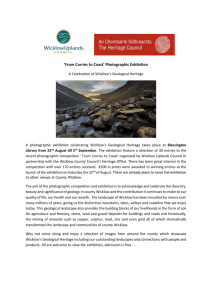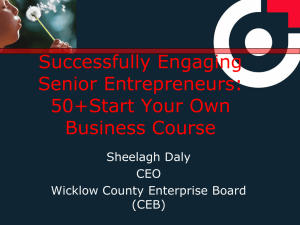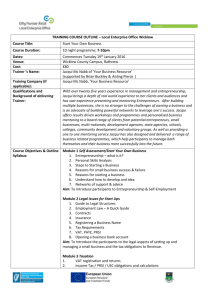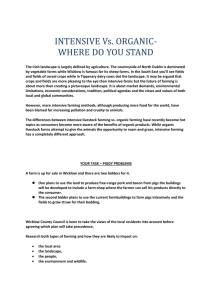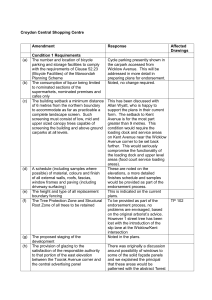File - County Wicklow Public Participation Network
advertisement
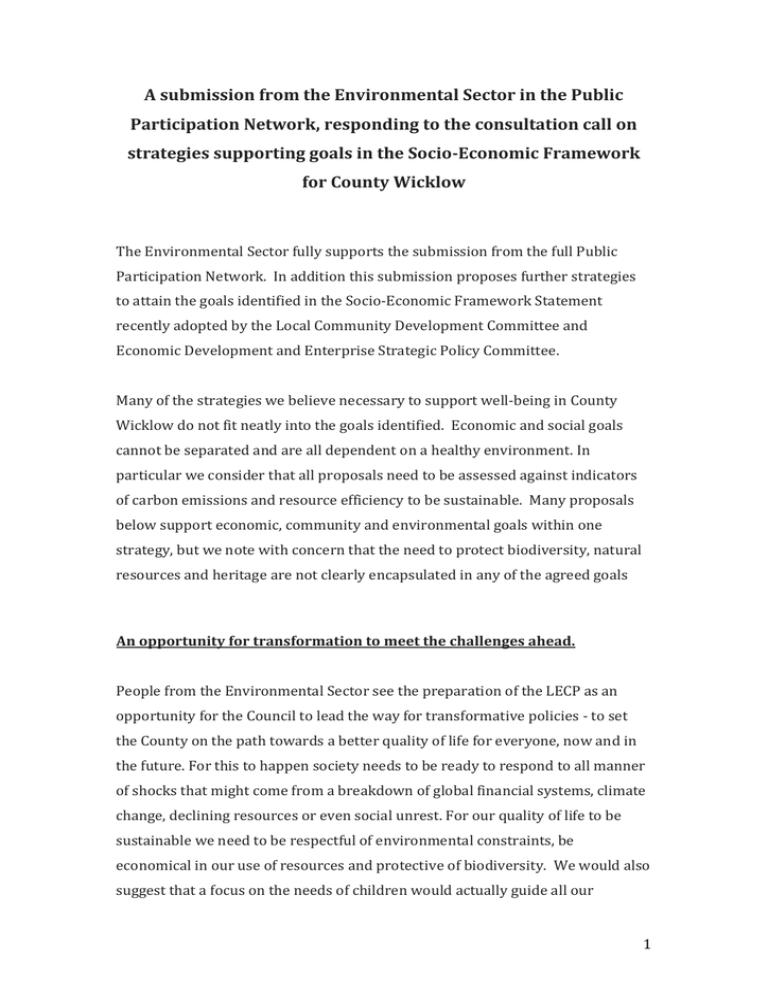
A submission from the Environmental Sector in the Public Participation Network, responding to the consultation call on strategies supporting goals in the Socio-Economic Framework for County Wicklow The Environmental Sector fully supports the submission from the full Public Participation Network. In addition this submission proposes further strategies to attain the goals identified in the Socio-Economic Framework Statement recently adopted by the Local Community Development Committee and Economic Development and Enterprise Strategic Policy Committee. Many of the strategies we believe necessary to support well-being in County Wicklow do not fit neatly into the goals identified. Economic and social goals cannot be separated and are all dependent on a healthy environment. In particular we consider that all proposals need to be assessed against indicators of carbon emissions and resource efficiency to be sustainable. Many proposals below support economic, community and environmental goals within one strategy, but we note with concern that the need to protect biodiversity, natural resources and heritage are not clearly encapsulated in any of the agreed goals An opportunity for transformation to meet the challenges ahead. People from the Environmental Sector see the preparation of the LECP as an opportunity for the Council to lead the way for transformative policies - to set the County on the path towards a better quality of life for everyone, now and in the future. For this to happen society needs to be ready to respond to all manner of shocks that might come from a breakdown of global financial systems, climate change, declining resources or even social unrest. For our quality of life to be sustainable we need to be respectful of environmental constraints, be economical in our use of resources and protective of biodiversity. We would also suggest that a focus on the needs of children would actually guide all our 1 thinking on both economic and community goals. Future profiles of the county need to be more broadly based to identify the many distinctive qualities and resources in Wicklow: The socio economic profile recently circulated is valuable in describing the human resources here yet falls short in identifying other assets and distinctive features including the stunning landscapes, the range of habitats, areas of fertile soils, access to rivers and the coast etc. The potential for international inward investment is limited in a county where 27% of the people live outside of urban conglomerations (and 23% in open countryside) so, whilst not rejecting the jobs potential of large corporate proposals, it would be unwise to neglect the opportunities offered by small scale local enterprise, including social enterprise. The smart green economy The environment will provide many of the resources that will be needed to underpin economic development in the county so that more people can work closer to home and escape the commuter life style that research has shown to be damaging to individual and society's health. There are already models for this in the county and it would be helpful to map this out. There is a firm foundation of existing organisations, business and individuals established to train individuals and communities in sustainable living, for example An Tairseach and Carraig Dulra. There are local, low carbon businesses and existing networks such as the Sustainable Living Network and Commonground. These should be supported. It would strengthen the trend to brand Wicklow County as a leader in environmentally based enterprise. Look at Wicklow first and foremost as a 'Green/Eco landscape which has got built and urban areas in it. Sell this brand to central government as an internationally attention-grabbing initiative (like the 2 smoking ban). Persuade them that they need a test bed for a new 'Green and Pure Ireland'. Local business will benefit from trading under such a unique Wicklow brand. As it is, the years ahead will see more and more stringent environmental constraints on the way that they operate: all the more reason to embrace the inevitable and pioneer a new way now while it is still novel. Let Wicklow seize the initiative and attract cutting edge business keen to be associated with the environmental image STRATEGY. Expand the socio economic statement to include a broader range of assets, including for example environmental assets and existing business that focus on ‘sustainability’. (GOAL 5) STRATEGY: Develop the Wicklow brand to highlight the forward thinking approach to a green low carbon economy and sustainable living. (GOAL 9.) Climate change. Climate change will impose it's own constraints. ( see appendix for further comment on this). Global and national agreements will require local compliance to reduce carbon emissions. See, for example, the preparations for the National Mitigation Plan to transition Ireland to a low carbon economy by 2050. Better to be on the right path now than having to unpick poor decisions at a later stage. Many of the policies that work to reduce carbon emissions also have a positive impact on other aspects of life. Localisation is the obvious example of this: reducing commuting has environmental and social benefits, STRATEGY: Establish A Local Energy Agency with goals to make the transformation to a new energy system and in the process transform our local economy by building the technical innovation required to deliver a new energy system. (GOAL 9.) 3 STRATEGY: Ensure all local government buildings are resource efficient (GOAL 9) STRATEGY: Promote energy efficiency and insulation among low income households. Monitor the number or % of homes availing of the SEI Better Energy Homes and the Warmer Homes Schemes for disadvantaged households, Number of houses completed to Passive House Standard or A3 minimum BER rating (GOAL 9) STRATEGY: Support Community Energy Projects Such As Ballinagran Energy Plus Project (GOAL 9) STRATEGY: Encourage and Support Community Bio-digesters (GOAL 9) STRATEGY: Prepare Coastal Zone Management Plan To Consider Potential Future Flooding And Erosion (GOAL 9) Local food production and other businesses based on Wicklow’s natural resources Localisation not only reduces commuting, thus improving quality of life, but has economic and social benefits. Local organic food production reduces oil and oil based fertilisers imports as well as increasing food security and providing a healthy occupation for a wide range of workers. A range of strategies could stimulate and develop existing initiatives though many groups may need assistance to access any help that is available. STRATEGY: Appoint a funding officer to assist communities and individuals source grants and credit facilities. (GOAL 4) 4 STRATEGY: Identify council land and property that may be suitable for local business . (GOAL 4) STRATEGY: Identify all vacant properties, for example, disused factories and retail premises, unoccupied houses and derelict sites in County Wicklow (whether owned by the Local Authority or in private ownership) so that active citizens who want to be part of the change and transformation to a new local economy that is independent of fossil fuels can negotiate terms for the use of such properties and start the enterprise. Lack of access to work space is a key hindrance to enterprise (GOAL 4) STRATEGY; Where Council support is provided (possibly in the form of reduced rates or development levies) recipients should be required to adopt a 20% local employment policy such as adopted in Docklands and Grangegorman Developments. (GOAL 7) STRATEGY; All applications for funding should be proofed against level of carbon emissions and other environmental considerations. (GOAL 9) STRATEGY: Identify Council owned land suitable for community gardens, allotments, smallholdings and natural play areas. (GOAL 4/7) We fully support the submission from Commonground/Edible Bray which very specifically proposes the development of creative community solutions to food security in the Bray Area i.e. a community nursery, a community orchard and community allotments. STRATEGY: Identify suitable soils for protection, existing local food production enterprises (see strictlywicklow,ie) , abattoirs, etc., support existing business and explore potential opportunities to process and market local food. (GOAL 4/7) 5 STRATEGY: Promote community and school gardens, include training and education, to provide a means of integrating people, providing for some of their food and recreational needs, to promote good physical and mental health, and to help combat obesity GOAL 9 STRATEGY: Support local food banks to assist low-income households (GOAL 3) STRATEGY: Support schemes for Community Assisted Agriculture, linking farms or groups of farmers and growers with specific communities, including low income households, to provide food directly, giving the farmer a guaranteed income and putting the farmers ‘face’ on the food. This may include communities helping directly with production and harvesting. (GOAL 7) STRATEGY: Support local co-operatives and local festivals to strengthen community bonds and develop resilience ie the ability to bounce back from shocks to the local economy or society. (GOAL 2) STRATEGY: Explore the potential to increase wood related business. Wicklow is the most heavily wooded county (GOAL 7) STRATEGY: Support environmental projects such as Avonmore Forest proposal reconnecting Wicklow’s oldest woodlands (GOAL 5) Children A focus on the needs of children could also be effective as a guide to future community development. In Ireland, Drogheda, Derry and the City of Galway have adopted recommendations that will help them to achieve the European Child Friendly City status. The issues that were examined include: The relevant policies of the local authority The demographics of the child population, age groups and areas of the town or city with high or low child populations 6 How the voices of children and youth are considered in the decision making processes of the local authority, agencies and community organisations. What facilities are provided for children and youth, in terms of playgroups, holiday play schemes, after school clubs, playgrounds, recreational facilities, youth clubs, programmes for disadvantaged children and youth. Who provides these facilities and where. Questionnaires to schools, youth and community groups concerning children’s involvement and their needs, (this can be done through Comhairle na nOg, Proposals to make the area more child friendly. These can include providing new playgrounds and recreational facilities, safer routes to school, including improved footpaths, cycleways and road crossings especially near schools, public transport, Home Zones and improved and extended youth programmes. Tackling educational disadvantage may also be an issue in some areas. Priorities may also be attached to these issues where funding may be a concern. It is important that the process is not seen as being solely a local authority issue as all stakeholders need to be involved if any progress is to be made. Mental health services for young people in Wicklow need to be strengthened and promoted. STRATEGY. Plan to achieve Child Friendly County status. (GOAL 3) Such policy would also play well into the development of Tourism. If Wicklow become the first County to attain status as a child friendly tourist destination if could provide the competitive edge that is needed to draw more people to visit and stay in the county. Education When considering the educational needs of communities in County Wicklow this should also acknowledge the benefits of early learning, including from birth to 3 7 years. This has been shown to have more benefits than at any other stage in life despite the obvious value of education and training for adult learners and for older people. There will also be an increasing need for education for sustainable living to prepare communities for changing times and Claremont College may be well equipped with facilities and land to provide a suitable base for much of this. Similarly, the new Wicklow Hedge School network may provide a good model and emerging example of what parents want in order to bring children’s education back to nature. STRATEGY: Develop a plan to offer early education to all (GOAL 3) STRATEGY: Develop Claremont College as a centre for research and education in Sustainable Living and add a 3rd level component to existing education and cross-disciplinary research. (GOAL 8/9) Health Health and well being are closely linked. For example peoples perception of health are now used as an indictor of well being in the national census. There is also considerable research to show that in urban areas, access to green space provides protection from physician-assessed morbidity, including depression and anxiety disorders, particularly for children and those living in deprived areas (Maas et al., 2009). Self-rated health measures have also been found to correlate with green space (Mitchell & Popham, 2008). Villeneuve et al. (2012) found that mortality rates were lowered in areas with higher levels of green space. In Ireland research on health benefits of green space have focused on air quality, obesity levels, and social connectedness (Combat Poverty Agency, 2008). Physical activity protects against poor mental and physical health (Department of Health, 2009)and proximity of green space is related to improved mental 8 health and well-being indicators for children (Marmot, 2009).European public policy encourages tackling health inequity by addressing the social determinants of health, including environment. Population-based health promotion and prevention sited at the environmental level takes account of the interaction of the individual with their social and cultural context and may be more effective in ameliorating health outcomes by reducing risk for all. Such interventions avoid labelling at-risk children and their families, more easily achieving buy-in from all in the community with the increase in social cohesion such support engenders. STRATEGY: Census figures relating to perception of health should be identified in future revisions of the Local Economic and Community Plan as a means to monitor the impact of developments on well being and quality of life (GOAL 3) STRATEGY: Map existing areas of accessible green space in the County and develop a strategy to improve access, extend accessible space and maintain existing green space in good condition (GOAL 1) STRATEGY: Provide recreation facilities in council owned parks such as car parks (Brittas Bay), which would augment the natural amenities already existing such as beaches. (GOALS 1/4/7/9) ‘Good health’ is synonymous with ‘promoting the well being and quality of life of our community’. Suicide - depression - social isolation - obesity - drug and alcohol abuse - domestic violence - poverty - homelessness - child abuse - mental health, are all issues dealt with by GPs every day and are essentially social and economic issues that are the subject of this Local Economic and Community Plan. Strategies that address environmental issues will have an impact on health. For example a strategy regarding local food production will impact positively on 9 Health (even if we consider the narrow definition of ‘health’ ) Strategies aimed at the walkability of communities, both rural and urban should/would be picked up in the County Development Plan - another example of the health impacts of environmental strategies. We are concerned at reports that today there are over 10 rural communities in Ireland without a GP and growing. Watch what happens in Wicklow. Within the next 10 years many of the existing GPs will retire and finding replacements will be extremely difficult. Rathdrum, Shillealagh, Tinahealy, Carnew, Roundwood communities are especially vulnerable. This could end up being a far bigger issue, for example, than supporting first responders. A number of strategies can be adopted to respond to this challenge and the Environmental Sector fully endorse the submission from Dr. Craig Bishop, a founder member of the Wicklow Planning Alliance, which highlights the integrated nature of strategies to improve health outcomes attached to each goal adopted in the Socio Economic Framework Statement. Housing Health and Well being are also linked to housing. STRATEGY: The Council should identify land that could be serviced and made available for local initiatives such as Community Land Trusts as a way of providing affordable home ownership. Such Trusts should be encouraged and supported where they arise. (GOAL 1) STRATEGY: Mortgages and business credit may be made available via Public Banks, which could include Local Authority reps in their governance. This should be supported where it arises. (GOAL 1) STRATEGY: Consider the construction of temporary small wooden houses for emergency housing for some of the 300 homeless families in county Wicklow. (GOAL 1) 10 Tourism Most visitors to Wicklow are coming to walk in the magnificent landscape of the mountains. It is the role of the County Development Plan to protect this environment, for its own sake and for its contribution to the local economy. It may be the role of this Economic Plan to ensure that local towns can capitalise on this market and develop alternative walking routes to reduce the pressure on Glendalough. The Greenway around Blessington Lakes is now nearing completion and many others are in the process of development. STRATEGY: Support local communities develop walking routes along the coastal plain and cliffs, linking into coastal walks in Dublin and Wexford. (GOALS 1/4/7/9) STRATEGY: Create urban walking trails in our towns that highlight the cultural, historical and architectural places of interest. This will promote civic pride and encourage tourists to stay longer and visit locations within an area not normally visited. Will require maps and more favourably an on-line app that will provide the mapping and possible links to further information on designated sites. GOALS 1/4/7/9. STRATEGY; Develop themed tours highlighting different features of the County including Spritual Centres, both main stream and alternative such as An Tairseach Wicklow Town, Chrysalis, Luisne, Glendalough Hermitage, Old Rectory Donard, Magheramore Convent, etc etc. (GOALS 1/4/7/9) STRATEGY; encourage child friendly tourist ventures (GOALS 1/4/7/9) The Arts Artists have a valuable role to play in modern industry with design playing an increasingly important role. See 11 http://www.keepeek.com/Digital-Asset-Management/oecd/industry-andservices/tourism-and-the-creative-economy_9789264207875-en#page4 There are many artists in the County and this can be another unique selling point in drawing business to the area. Employment for “Creatives” can be intermittent and uncertain but there is potential to develop databases specifically to help link artists to commissions and other work. Projects such as Painting the Quays, in Wicklow Town, can do much to improve the industrial parts of a town and could be encouraged and supported where necessary. STRATEGY: Develop suitable databases to link the artistic community in County Wicklow with businesses possibly working with organisations such as Business to Arts to develop creative partnerships between the arts and business communities. (GOALS 4/5/7) STRATEGY: Identify Council and other Government buildings, which might make suitable workshops for artists. Work with the Planning Department to deliver planning policies that facilitate living/working accommodation for artists in industrial buildings as is now very common in California. (GOALS 4/5/7) END This submission is a composite document prepared and agreed by the Environmental Sector of the PPN whose registered members are the Wicklow Planning Alliance, Brittas Bay Coastcare Group, Friends of the Murrough, Carraig Dulra and River Vartry Protection Society, with additional contributions from Commonground and EdibleBray Contact. Judy Osborne. Designated representative of the Environmental Sector on the Local Community Development Committee and Economic SPC. judydaleosborne@gmail.com Tel 086 36 99 575 See 10 high level goals adopted beow: 12 13
